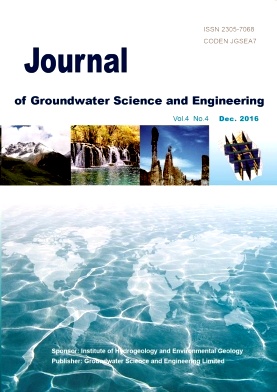ZHOU Xun, WANG Xiao-cui, CAO Qin, LONG Mi, ZHENG Yu-hui, GUO Juan, SHEN Xiao-wei, ZHANG Yu-qi, TA Ming-ming, CUI Xiang-fei. A discussion of up-flow springs[J]. Journal of Groundwater Science and Engineering, 2016, 4(4): 279-283.
| Citation: |
ZHOU Xun, WANG Xiao-cui, CAO Qin, LONG Mi, ZHENG Yu-hui, GUO Juan, SHEN Xiao-wei, ZHANG Yu-qi, TA Ming-ming, CUI Xiang-fei. A discussion of up-flow springs[J]. Journal of Groundwater Science and Engineering, 2016, 4(4): 279-283.
|
A discussion of up-flow springs
-
ZHOU Xun, ,
-
WANG Xiao-cui,
-
CAO Qin,
-
LONG Mi,
-
ZHENG Yu-hui,
-
GUO Juan,
-
SHEN Xiao-wei,
-
ZHANG Yu-qi,
-
TA Ming-ming,
-
CUI Xiang-fei
-
1School of Water Resources and Environment, China University of Geosciences (Beijing), Beijing 100083, China. 2Key Laboratory of Groundwater Circulation and Evolution (China University of Geosciences, (Beijing)), Ministry of Education, Beijing 100083, China. 3School of Environmental Science and Engineering, Qingdao University, Qingdao, Shandong 266071, China. 4Education Centre of Jiangxi Geological Exploration Bureau, Nanchang, Jiangxi 330030, China.
More Information
-
Corresponding author:
ZHOU Xun, zhouxun@cugb.edu.cn
-
Abstract
Based on their genesis, springs are commonly classified as depression spring, contact spring, overflow spring and fault spring, etc. In addition, a kind of springs, i.e., up-flow spring, can be found in the field. An aquifer is overlain by poorly-permeable unconsolidated sediments or relatively impervious formations. If the hydraulic head of the aquifer is higher than the land surface, groundwater may flow up to the ground surface through the local portion of the overlying aquicludes where the permeability is relatively good, and emerges as an up-flow spring. The common characteristics of an up-flow spring are discussed and summarized in this paper, and some examples of the up-flow springs are also given. Up-flow springs can flow up through local permeable zones in the overlying aquicludes rather than permeable faults. Although they cannot be found as frequently as depression springs, contact springs, overflow springs and fault springs etc., yet up-flow springs may occur in the form of normal-temperature springs, hot springs and salt springs.
-

-
-
Access History







 DownLoad:
DownLoad: